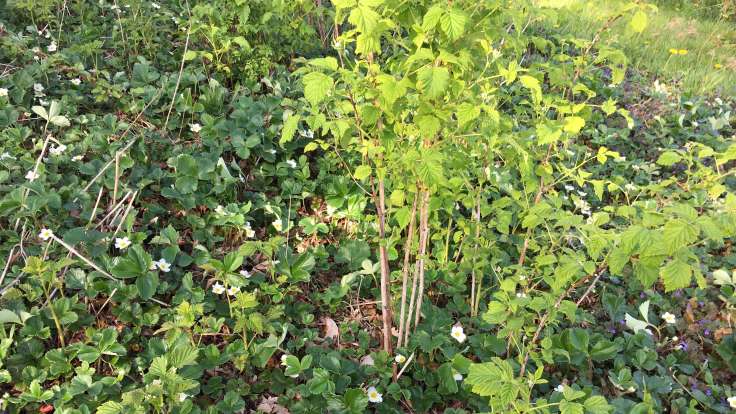
Raspberries and strawberries in the forest garden Fruit Triangle
A forest garden works with nature to grow edible crops, which is why it’s good for climate change. Here are the reasons why.
Climate change is caused by living in an unsustainable way. Forest gardens by definition are a sustainable and sustaining form of gardening.
- A forest garden is self-sustaining because, once it’s established, it doesn’t require any extra inputs. This means fewer demands on the world’s resources.
- As a forest garden is a balanced ecosystem, it provides its own pest control and its own fertility.
- There is a diversity of species, for the health of garden and also for a more interesting diet. You don’t want to eat the same thing over and again!
- A forest garden provides habitat for wildlife. Cut ’n’ drop mulching, composting in place, leaving brash on the ground or in dead hedges; all of these provide habitat.
- Permanent living ground cover, in the form of ground cover plants, means soil is undisturbed and soil life can get established. This includes mycorrhizal fungi network, which helps move nutrients between plants.
- Trees and soil life capture carbon. A mature tree captures around 20kg a year and there are about 20 full sized trees and a hundred or so smaller trees and shrubs in our forest garden.
- Because of the interconnected plants, a forest garden absorbs and retains more water, which means less run-off, which helps prevent flooding.
- By design, a forest garden is low-maintenance, so people are more likely to stick with gardening, ideally meaning more forest gardens, meaning more sustatinable environments.
- If people are in the forest garden growing their own produce, it means they consume less from elsewhere.
- Involvement in any garden, particularly a forest or wildlife garden, increases an awareness of the essential nature of nature. We are part of nature, by definition we can’t live without it.
- A forest garden is a resilient garden, providing shelter from extremes of wind and sun, providing a harvest from one source if another harvest fails.